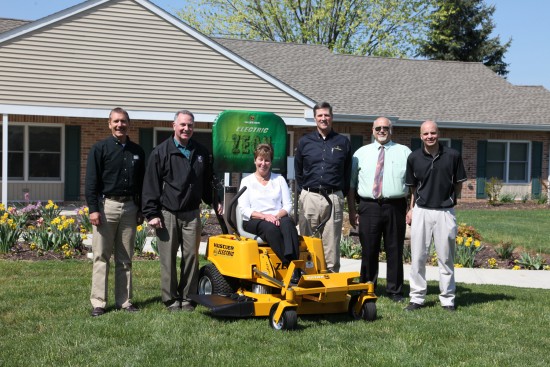How many times each month do you get asked for a donation of money, products or services? Plenty, I’m sure. And, I’m also sure you give gladly. What if that donation could do more? What if the steer you bought at the 4-H auction could lead to increased revenues or smarter, happier employees? One expert says it can — and should.
 Lisa McAlister, Principle, With Good Cause |
Lisa McAlister is Principle at With Good Cause, a Boulder, Colo.-based marketing agency that specializes in corporate social responsibility (CSR) programs. She says business owners often give because it’s the right thing to do. However, a more formal approach to giving that includes measuring its impact, can make donations do more for the community — and the dealership.
“When you create measurements for giving, it results in better impact. Measuring the success of each effort helps tell a story that goes beyond the ‘feel good’ part of the effort,” says McAlister.
"It’s important to have intention around everything you’re doing, maybe even more important for small businesses, because you don’t have resources to waste.”
Here, McAlister answers questions about developing a strategic CSR program for your dealership.
Tell me more about the stories that come from giving. How will that benefit my dealership? Advertising impact or something else?
When you’re telling stories just to build your reputation, it’s about making sure people who don’t know you think that you’re doing good. To me, stories related to corporate giving are about new ways to reach new customers and new ways to engage them. Then, they will look to your company’s products and services.
It’s the action part: repeat business, customer loyalty, and standing apart from the competition. And, one of the biggest benefits is employee retention and satisfaction. Also, employees who volunteer increase their core competency skills. They’re out there doing things that increase skills in communication and customer service. That’s a training trade-off that you are getting — and your employee is enjoying it.
How do I start developing a better program?
The first step is to evaluate what you’re doing now. You won’t know if you’re successful if you don’t know where you started. How deep you go into that effort is up to you. If you think your program is doing OK, you just may need to look at the pros and cons and the resources being allocated. If you’re feeling overwhelmed, you may need to go deeper than that.
Next, outline what you want to achieve. Is it revenue, employee satisfaction, your impact in the community? Part of that outline is to develop your CSR statement. That statement should be tied into your company’s mission statement. For instance, if customer service is one of your values, then that should be part of your CSR statement as well.
Another important step is your communication plan. What is your plan for reaching customers and employees and engaging them in your efforts?
Finally, measure everything you do. Tie your CSR efforts to a brand or product. Then, after a community event, for example, measure whether or not sales went up. If you’re working with a non-profit, ask them for statistics about how effective they are in the community, and whether that changed throughout your partnership. And, measure employee satisfaction. How do they feel about your company as a result of the effort?
What can I do today for requests I’m getting?
Make a decision about where you want to commit your money for the next 60 days. You don’t have to scrap everything and start over. If you’re doing repeat events, you just need to have a conversation about what you’re expecting, the intention of that donation. That sets the tone for the relationship.
Is there an accepted percentage or formula to determine the level of my CSR program?
There’s no formula, but you can think in terms of resources — what resources I have and what kind of impact do I want to make. You can think in terms of customer touch points, too. If you only sponsor two events or programs a year, then they need to be larger than if you’re sponsoring more.
What about saying no?
I know how difficult that is. Always thank them for thinking of you. Be genuine for why you can’t participate. See if you can offer them an alternative partner. Or, maybe you can offer an alternative way to become involved, such as through volunteering.
Learn more:
Lisa McAlister and With Good Cause offer a free, 12-step series for developing your CSR program. Go here to see the recommended 12 steps. Then, sign up to receive monthly communication tied to that step.
Dealership Donation Supports Long-Time Customer
Hustler Turf Equipment is teaming up with its dealers for its Zeon donation program. Zeon is the company’s zero turn electric mower.
 Power Pro Equipment of Pennsylvania recently donated a Hustler Turf Zeon electric mower to LutherCare Retirement Community. From left, Jim Martin, Power Pro vice president, Carl McAloose, Luthercare chief executive officer, Verna Martin, Power Pro Equipment owner, Frank Nuss, Hustler Turf representative, Phil Sahadey, Luthercare, and Brent Eshleman, Power Pro sales.
Power Pro Equipment of Pennsylvania recently donated a Hustler Turf Zeon electric mower to LutherCare Retirement Community. From left, Jim Martin, Power Pro vice president, Carl McAloose, Luthercare chief executive officer, Verna Martin, Power Pro Equipment owner, Frank Nuss, Hustler Turf representative, Phil Sahadey, Luthercare, and Brent Eshleman, Power Pro sales.
Brent Eshleman, a salesperson for Power Pro, a Hustler dealer with four locations in Pennsylvania, suggested Luthercare Retirement Community as an organization that could benefit from the donation. The non-profit residence center has been a Hustler customer for 18 years.
The facility uses the mower in areas where quieter mowing benefits the residents, such as near outdoor activity areas, the community center and assisted living units.
“Luthercare is a well-respected, nice facility that already had green initiatives. We had an established relationship with them and we could build on that,” Eshleman says. He is working with the facility now on a possible purchase of another Zeon mower.





Post a comment
Report Abusive Comment